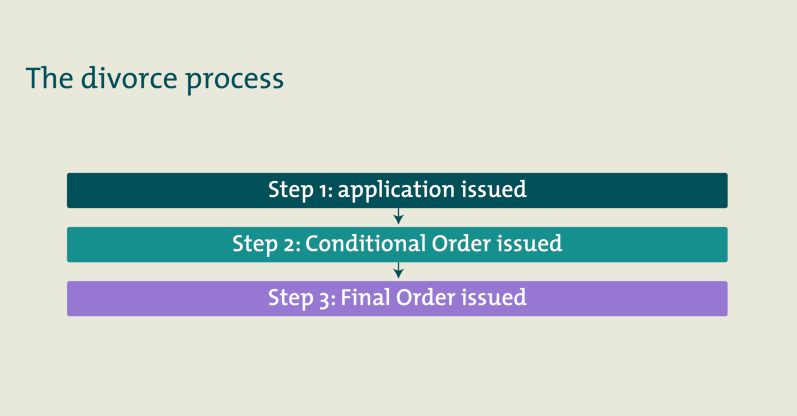We provide guidance on how you can apply for a Conditional and Final order, once your application for divorce/dissolution has been issued at Court.
There are three steps to obtaining a divorce/dissolution in England and Wales:
Step 1: issue your application
Step 2: Conditional Order, formally called Decree Nisi
Step 3: Final Order, formally called Decree Absolute
We have produced a flowchart on the divorce and dissolution process in England and Wales.
You can apply for your divorce/dissolution, Conditional Order and Final Order online via the HMCTS portal. If you have instructed a solicitor to handle your matter, they can deal with matters online for you. You can also apply by post.

Step 1: issue your application
The first step is for your application for divorce/dissolution to be issued at Court.
You cannot submit your application until one year of your marriage or civil partnership has elapsed. You are required to provide your marriage/civil partnership certificate and the court fee. You must also ensure that the court has jurisdiction to deal with the divorce/dissolution.
If you submit the application you are known as the applicant and your spouse will be the respondent. If you bring the application together with your spouse, one of you will be called applicant 1 and the other applicant 2; you will be known as joint applicants.
For proceedings issued on or after 6 April 2022 there is one ground for divorce/dissolution: the irretrievable breakdown of the marriage/civil partnership.
The party who did not apply for the divorce/dissolution will be served with the application and an acknowledgment of service within 28 days of the date of issue. They will be required to complete and return the acknowledgement of service within 14 days.
Step 2: Conditional Order
Once you have issued your application for divorce/dissolution and the other party has acknowledged this, the next step is for the applicant(s) to apply for a Conditional Order. The application for a Conditional Order can only be made a minimum of 20 weeks from the date the initial application is issued.
The court reviews the application and, if satisfied that the criteria are met, grants a certificate of entitlement to the Conditional Order and sets a hearing date for pronouncement. It may take several weeks for the court to review your application for a Conditional Order and for a hearing date to be set. A judge will pronounce your Conditional Order at the hearing. You only need to attend the hearing if you want to object to any of the orders which are being made. Once the Conditional Order is granted, the court sends a copy to both parties.
It is possible to withdraw an application for divorce/dissolution and an application for a Conditional Order. If the application is made jointly, both parties will need to provide their written consent to the court for the application to be withdrawn. If the application is made by a sole applicant, it is possible for that party to withdraw their application before the other party is served. If the application has already been served, then the party that applied for the divorce/dissolution can apply to the court to dismiss the divorce/dissolution application.
A Conditional Order does not finalise the divorce or dissolution; instead, it is a document that says the court does not see any reason why you cannot end your marriage or civil partnership.
Step 3: Final Order
Once you have obtained your Conditional Order, the next step is to obtain your Final Order. You can apply for your Final Order 6 weeks and 1 day after the Conditional Order has been granted. If you do not apply for the Final Order within 12 months of getting the Conditional Order, you will have to provide a reason for the delay to the court.
Once the court receives your application for a Final Order, the court will check that the time limits have been met and that there are no other reasons not to grant the divorce/dissolution. If the judge is satisfied, they will proceed to pronounce your Final Order. The Final Order is typically granted within 24 hours of the application being submitted on the portal, however it can take longer.
Once the Final Order is granted, the court sends a copy to both parties. If you lose your Final Order, you can write to the court to request a copy, however you will incur a fee.
You need to obtain your Final Order before you are legally able to remarry. You can remarry as soon as the Final Order has been granted.
It is essential that all financial matters are finalised before you remarry. This can be by obtaining an order from the court or by making an application for financial provision. If you remarry or enter into a civil partnership without first having made an application for financial remedy, you will not subsequently be able to pursue a financial remedy application against your former partner. It is very important to take legal advice if you are thinking of remarrying or entering into a civil partnership in circumstances where there is no final financial order in place.
If you are remarrying, when you give notice of your intention to marry or form a civil partnership, you will be required to provide your Decree Absolute or Final Order. If your ex-spouse has died, you will be required to provide their death certificate.
The Final Order is the final stage of your divorce/dissolution. It is the legal confirmation that you are divorced or have completed a civil partnership dissolution.
If you have any queries about a Conditional or Final Order, contact our divorce solicitors.









